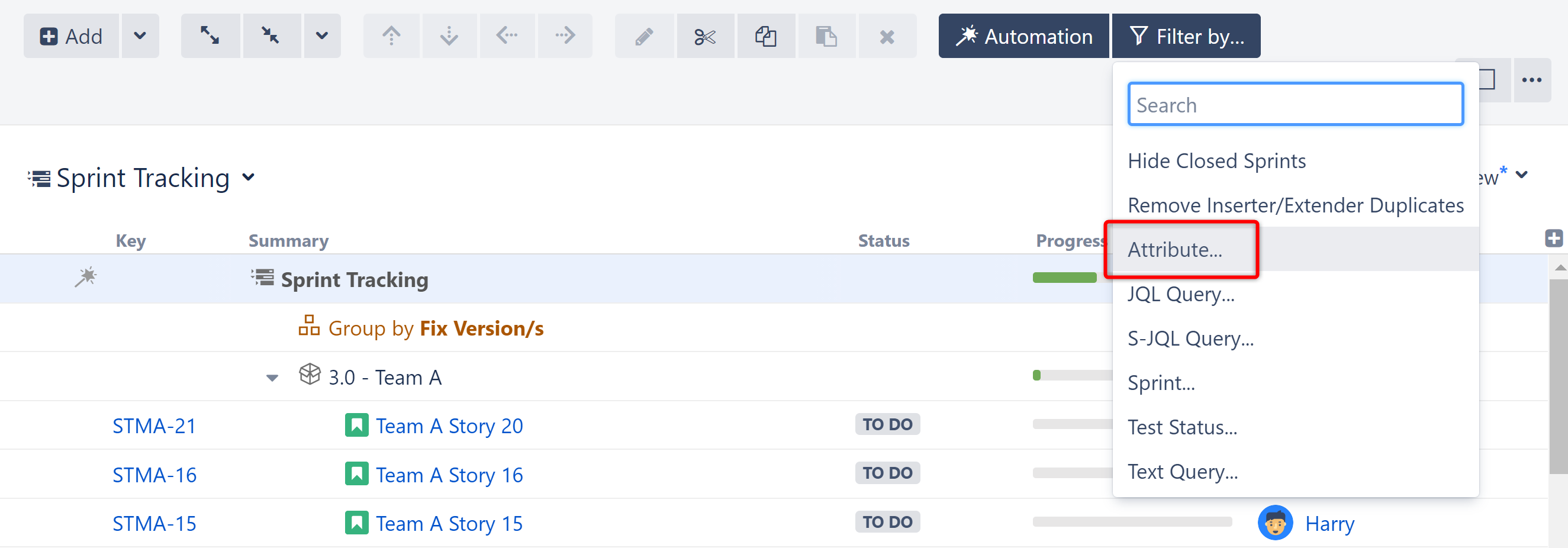The Attribute filter allows you to limit the issues in a structure based on the values in a specific attribute. To apply an Attribute filter to a structure, open the Automation menu, select filter, and choose the Attribute filter.

On the settings page, select the values for the filter:
-
Attribute - The attribute can be a Jira field, Structure field or attribute, Structure column, or even a formula.
-
Operator - The operator is used to compare values. Be sure to select an operators appropriate to the attribute value (string, numerical, date, duration, etc.).
-
Value - The value used for comparison.

Once applied, Structure will compare each issue's attribute value against the operator/value combination:
-
If the issue matches, it will remain in the structure.
-
If the issue does not match, and has no sub-issues that match, it will be removed.
-
If the issue does not match, but has sub-issues that do, the non-matching issue will remain but be grayed out.
Your filter settings may look a little different from the one above. Because we used a
formula
as our attribute, the section in gray was added so we could enter our formula and assign variables.
Examples
The following are just a few of the many possible uses for the Attribute filter.
Try filtering a structure by:
-
Time in Status - Use this attribute with the "duration longer" operator to identify issues that are taking too long in a particular status.
-
Formula - Filter tasks based on the results of a formula (for example, filter based on your internal KPIs, or show only overdue items).
-
Text filter - Filter a formula or notes column for specific words or strings.
-
Regex - Filter by regular expressions using the "contains" operator.
-
Multi-value fields - Use the "compare" operator to check all the values in the field against a single filter value, and keep any issues that contain a match.
-
Empty values - Use the "is empty" operator to identify zero values in numeric fields, spaces, empty lines, zero duration (estimates, work logged), and not-set values (like Unassigned).
-
Gantt Attributes - If you have Structure.Gantt installed, you can also filter by Gantt attributes (such as the Gantt Start or Finish date, or issues in the Critical Path). Note: Gantt attributes are only available when using the Filter by Attributes Transformation; Automation does not support Gantt attributes.
Requirements and Suggestions
Please note the following when configuring an Attribute filter:
-
Duration attributes - The value should be defined in Jira format (1w1d1h).
-
Progress attributes - Progress values should be expressed as a fractional or decimal number from 0 to 1. Note: a period should be used to express decimal values (ex. 0.5).
-
Username fields - To filter by a user-type attribute (Assignee, user-type custom field, formula that results in a username), the value entered must be the username, not the user's full name.
-
Group generators with an Attribute filter - If a structure contains both types of generators, the filter will run before the grouper - this could result in unexpected changes to the structure, and some groups may disappear completely if the accompanying issues are filtered out. See Order of Operation for Generators for more information.
